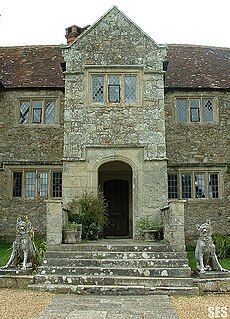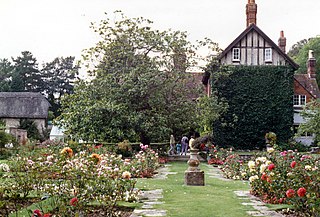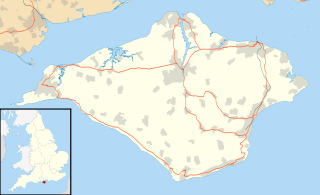
Arreton is a village and civil parish in the central eastern part of the Isle of Wight, England. It is about 3 miles south east of Newport.

Thorley is a village on the Isle of Wight, 1 1⁄2 miles (2.4 km) from Yarmouth in the northwest of the island and is 9 miles (14 km) west from Newport.

The Quarr Abbey House was one of several houses constructed along the north coast of the Isle of Wight in southern England. Built in the 19th century from the ruins of a Norman abbey, it was a residence of the Cochrane family and was later incorporated into the new Quarr Abbey monastery that was built on the site.

Priors Dean is a hamlet in the Hampshire Downs about 3 miles (5 km) west of Liss and about 4 miles (6.4 km) north of Petersfield, Hampshire, England. Since 1932 it and Colemore have been in a single civil parish of Colemore and Priors Dean. The nearest railway station is at Liss.

St Olave's Church, Gatcombe is a parish church in the Church of England located in Gatcombe, Isle of Wight.

Carisbrooke Priory was an alien priory, a dependency of Lyre Abbey in Normandy. The priory was situated on rising ground on the outskirts of Carisbrooke close to Newport on the Isle of Wight.

Arreton Manor is a manor house in Arreton, Isle of Wight, England. Its history is traced to 872 AD to the time of King Alfred the Great and his parents. It was left by King Alfred by his will to his youngest son Aethelweard. Once owned by William the Conqueror, as mentioned in the Domesday Book in 1086, in the 12th century it became part of Quarr Abbey and was used by the monks for over 400 years. In 1525, it was leased to the Leigh family. The manor was rebuilt between 1595 and 1612. Built in Jacobean style, it is in the shape of a "H". It is also widely known on the Isle of Wight in folklore for its paranormal activity, particularly the ghost of a young girl named Annabelle Leigh who was allegedly murdered at the manor by her own brother in 1560.

Morton Manor is a manor house originating in the 13th century, in Brading, Isle of Wight, England. It is located 1 mile (1.6 km) southwest of Sandown Road. The 14th century fairly small house was modified in the 19th century. Constructed of varied materials, it was refurbished and extended in the early 20th century in an Arts and Crafts style. A Tudor fireplace is in the dining room, with William De Morgan green glazed tiles. The manor includes a small museum of rural life.

Nunwell House, also Nunwell Manor, is a historic English country house in Brading, Isle of Wight. Located 3 miles (4.8 km) south of Ryde, the Tudor and Jacobean style house also has later additions. The house contains family militaria. It was occupied by the Oglander family from Norman times until 1980. Nunwell House is a Grade II* listed building.
Hill Farmhouse is an English country house in Brading, Isle of Wight. The 17th century farmhouse, a Grade II listed building, is located on Carpenters Road. It was constructed of local limestone. While the two storey gabled porch was an addition, the mullioned window to the left of the porch is an original. An arched doorway is Tudor style.
Pidford Manor is a manor house in Rookley, on the Isle of Wight, England. It is a five-bay Georgian style home on 11 acres (4.5 ha), accessed from the A3020 roadway.
Billingham Manor is a manor house lying about a mile south of the village of Chillerton on the Isle of Wight.

Wolverton Manor is a manor house in Shorwell, on the Isle of Wight, England. The original house was started by John Dingley, Deputy Governor of the Isle of Wight. The Jacobean style home, built by Sir John Hammond after the death of Sir John Dingley, is the second house built on the site. There is a two-storey porch which features a flat roof and hollow angle columns.

Northcourt Manor is one of three manor houses, along with Woolverton and Westcourt, that is located in Shorwell, on the Isle of Wight, England. It was begun by Sir John Leigh, Deputy Governor of the Island, in 1615, but was unfinished at his death. Northcourt is currently in use as a hotel.
Azor was one of the most powerful English landowners at the time of Edward the Confessor in the 11th century. He was a kinsman and chamberlain of Brihtheah, a bishop of Worcester and a former abbot of Pershore. He owned property from Lincolnshire down to the Isle of Wight in many counties and like another great landowner of the times, Toki, he also owned urban property in addition to his vast possession of lavish country estates. He is mentioned in the Domesday Book and appears in countless histories of English counties along with his sons, Goscelin, William, and Henry who inherited his estates after his death. The sons in particular are linked with the early histories of many of the major manor houses on the Isle of Wight.

The history of Barton Manor spans over 900 years and was first mentioned in the Domesday Book of 1086. It is a Jacobean manor house in Whippingham, on the Isle of Wight. While it retains two 17th century elevations, other frontages were renovated, as was the interior in the 19th century. Two medieval lancet windows originated at a former Augustinian priory. Barton is the most northerly of all the Island manor houses.

Standen House is an English country house located 1 mile (1.6 km) south of Newport, Isle of Wight. The 18th-century house has a brick front and features seven-bay windows, a porch with Doric columns, and triglyph frieze. Made of brick, it is located at the base of Pan Down. To its right is situated the park of Gatcombe, which itself lies in a valley which includes the winding River Medina. Gatcombe House lies opposite Standen House, separated by the river and woods. Great East Standen Manor is nearby.
Thorley Manor is a manor house just outside Yarmouth, on the Isle of Wight, England. Built in 1712, it features a modillion cornice, hipped roof, as well as tall chimneys.

Sheat Manor is a manor house in Chillerton, on the Isle of Wight, England. Considered to be one of the island's antiquities, Sheat manor house, is a fine old gabled mansion now used as a farmhouse. It has a pond and swans. It contains some interesting Jacobite carving. Sheat was one of the few properties whose Anglo-Saxon owner, Alaric, was not disturbed by the Norman invasion. It was run by the Urry family for some time.

Landguard Manor is a manor house in Shanklin on the Isle of Wight, England. Mentioned in the Domesday Book, over the centuries it was home to numerous notable gentlemen. It is a Grade II listed building. One of the finest known portraits by Sir Thomas Lawrence, English portrait painter and president of the Royal Academy, is located in its drawing room.















